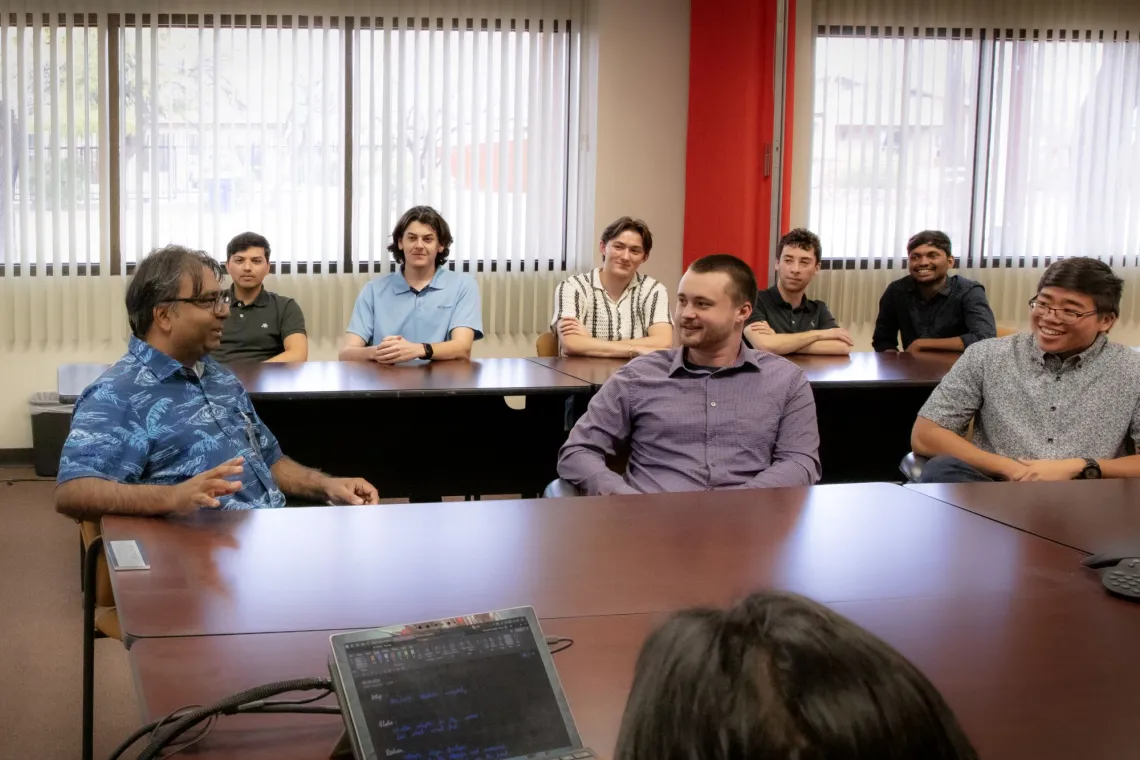University of Arizona inaugurates U.S. Space Command webinar series
The invitation highlights the university’s leadership role in space and national security.

Jekan Thanga, associate professor of aerospace and mechanical engineering, speaks to a group of students.
Leslie Hawthorne Klingler
The University of Arizona Department of Aerospace & Mechanical Engineering (AME) was invited by the United States Space Command (USSPACECOM) to give the inaugural webinar in its new series, “Deep Space Thoughts”. Jekan Thanga, associate professor of aerospace and mechanical engineering, led the webinar “Beyond Space Domain Awareness: Toward Integrated Space Operations in the 21st Century” last month.
“The invitation to give the inaugural webinar series reflects the agency’s growing collaboration with us,” said Cody Nicholls, associate director of National Security Programs for Research Development. “It is a privilege to help train the future space workforce and increase research and innovation related to space and national security.”
The University was selected to be USSPACECOM’s first Academic Engagement Enterprise member in 2022, a status that facilitates opportunities for students, faculty and partners to collaboratively address pressing challenges in human security, exploration, development and settlement of space.
The University is ranked first in astronomy and astrophysics expenditures at more than $123 million, representing 15% of all spending across U.S. colleges and universities. It has maintained this ranking since 1987 and has received significant NASA funding from the 1960s. Farzad Mahayek, department head of AME, is glad for the University’s ongoing leadership through Thanga’s research.
“Jekan is a leading figure in our department on the space side and has established strong relationships with the Lunar and Planetary Laboratory," he said. "This is a great opportunity for our department and the college to be involved in some of the most exciting research on campus. Jekan is also very productive on the education side and is working with a large group of undergraduate to doctoral students.”
In his webinar, Thanga highlighted the importance of proactive engagement within the space domain, particularly in cislunar space, the realm between Earth and the moon. He said that our investment in space, or lack thereof, will profoundly affect life on Earth as well as the comparative strength of the U.S. in the global milieu. Thanga discussed the importance of object identification in cislunar space as traffic increases due to the proliferation of satellites and space debris. The volume of space traffic is expected to grow exponentially with the introduction of mega-constellations, new space stations and on-orbit servicing facilities. If not adequately managed, cislunar congestion could stifle future growth prospects and limit access to space.
“A growing, busy cislunar space ecosystem is inevitable,” Thanga said. “While cislunar space represents a potential wealth of opportunity and transformation of life on Earth, we also face major challenges ahead in security and keeping the peace.”
Thanga emphasized the need to apply creative observation to space endeavors. For example, observations of superorganisms that have survived millennia, such as bee and termite colonies, suggest that feasible, economical and resilient space platforms and satellite swarms could be manufactured from smaller components such as the tiny, cost-effective small satellites. If faced with existential threats, these facilities could fall out of formation, disperse and then regroup elsewhere after the danger passes. Thanga clarified that while many enabling technologies such as 3-D printing of components, docking and robot-assisted assembly have been proven, fully autonomous assembly has yet to be tested in space.
To advance cislunar sciences, Thanga believes early career scientists and engineers looking for a challenge would do well to focus on developing scalable space-based monitoring systems to track space objects and threats or holistic solutions to collect and recycle space debris. He also mentioned the importance of designing and executing space traffic management guidelines that minimize the further accumulation of space debris.

